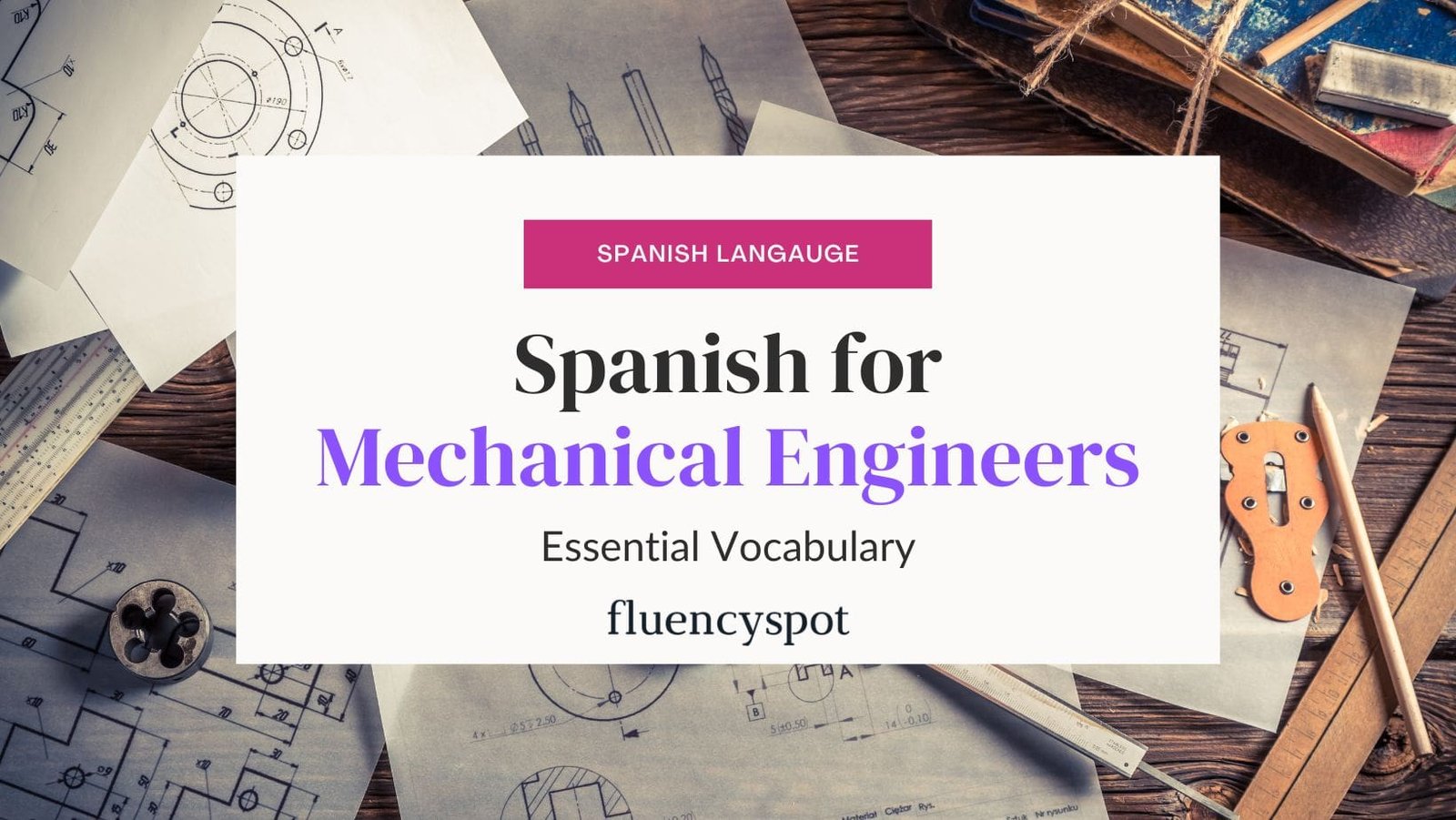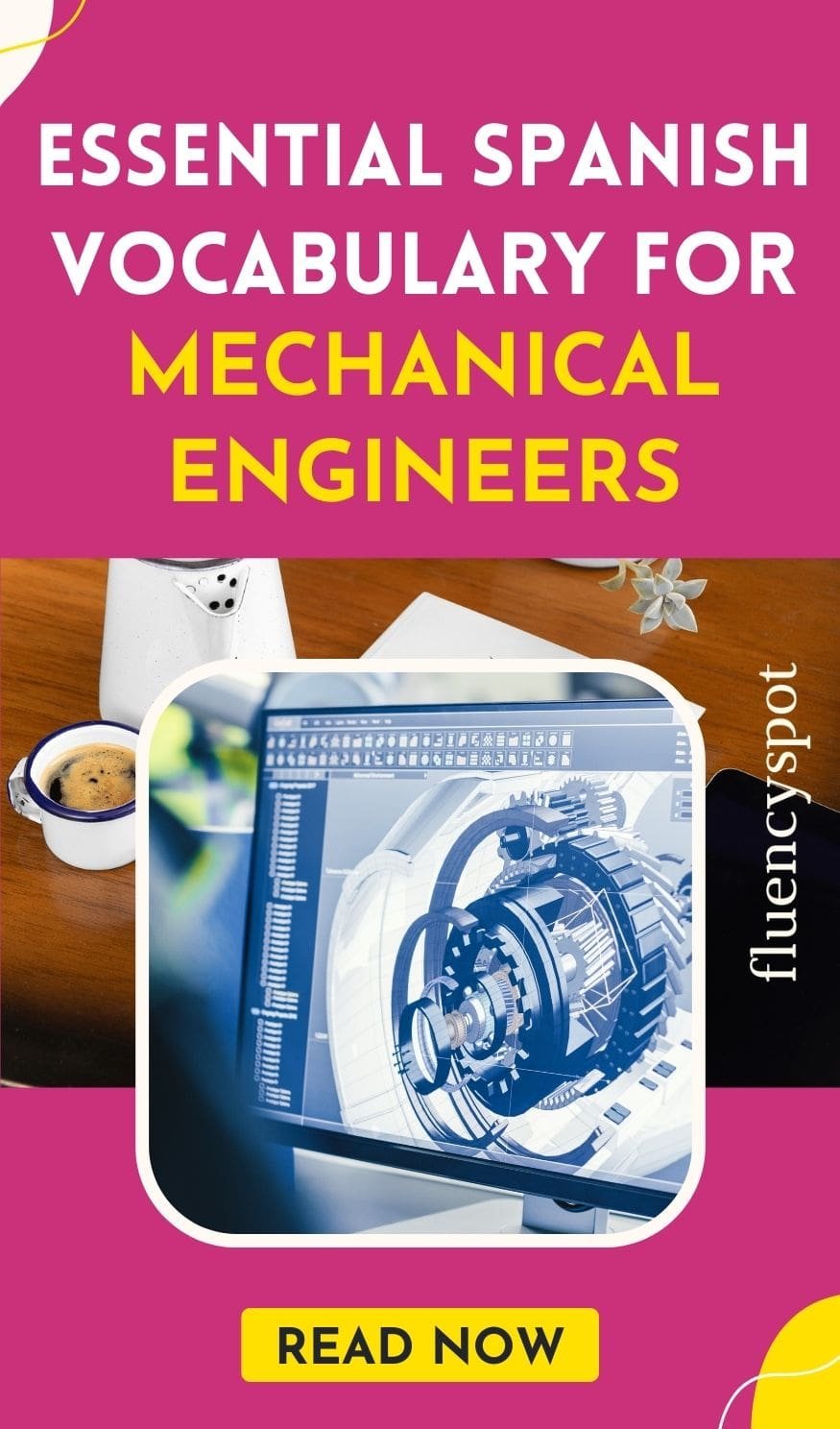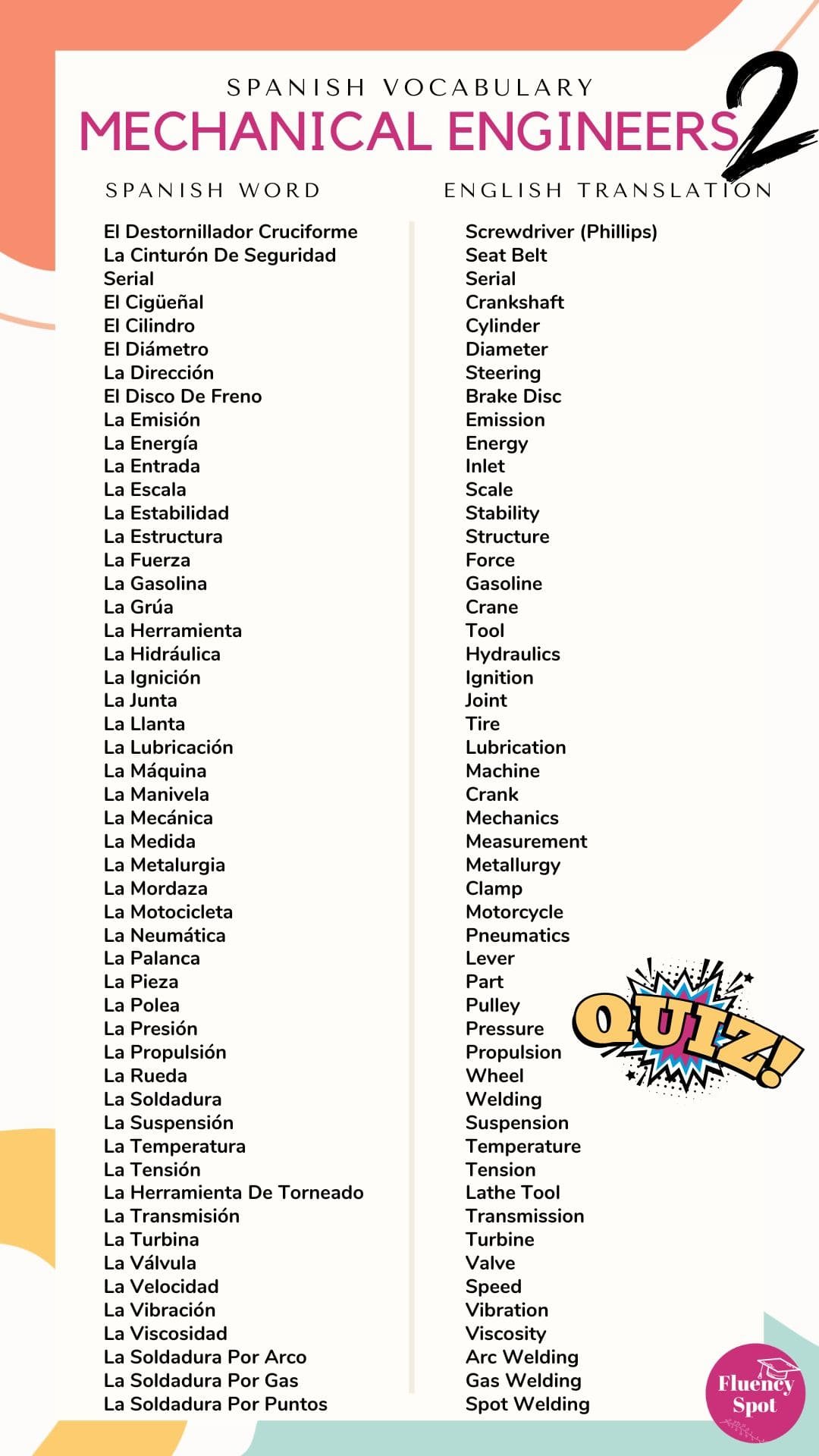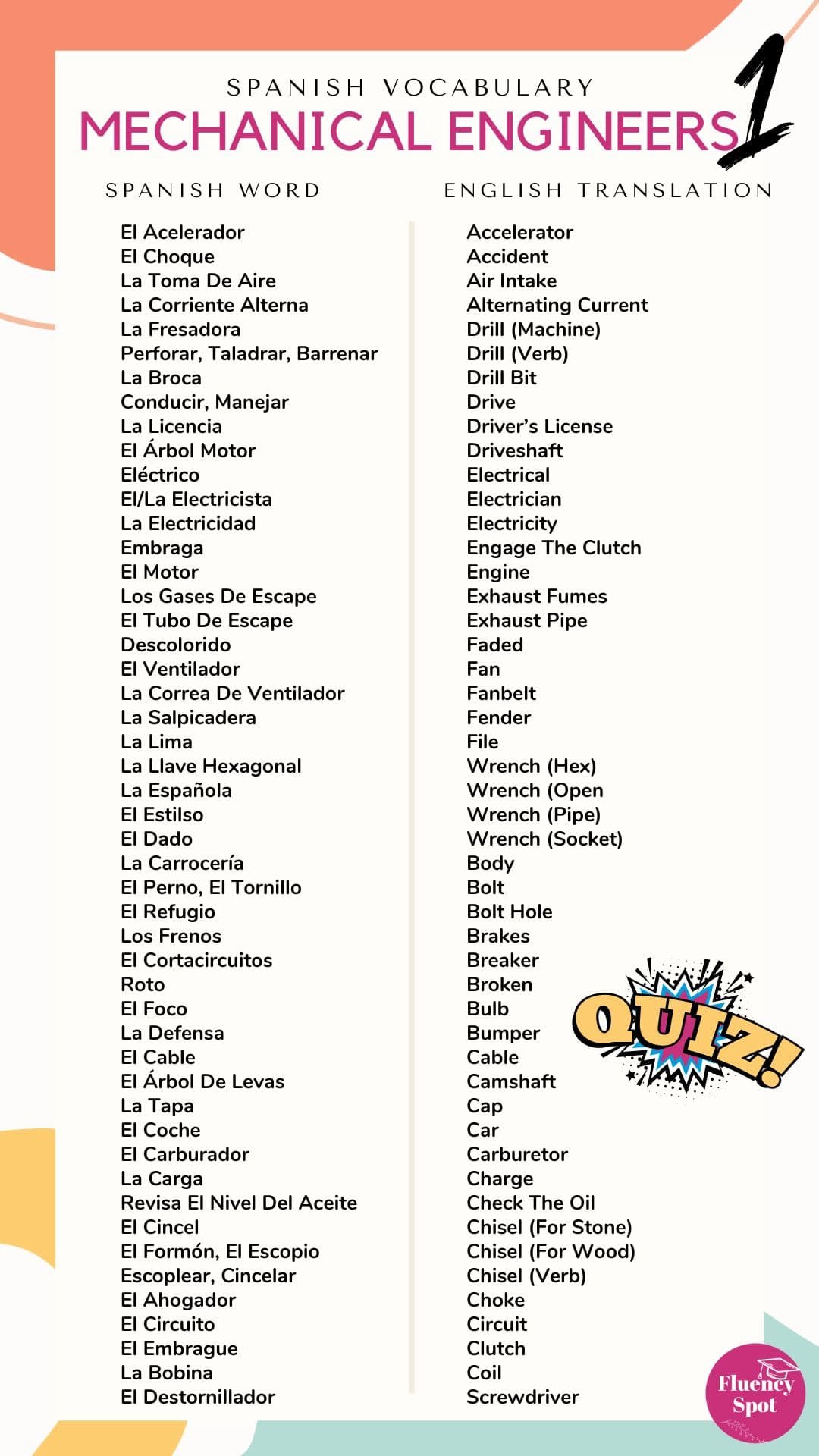No products in the cart.

Are you a mechanical engineer looking to expand your professional skills by mastering technical Spanish vocabulary? Whether you’re preparing for a job interview, communicating with Spanish-speaking colleagues, or simply enhancing your language skills, this article has you covered.
From common mechanical engineering terms and useful phrases to numbers, units, tools, equipment vocabulary, and safety and hazard terminology, we’ll delve into the essential Spanish vocabulary that every mechanical engineer needs to know. By the end of this article, you’ll be well-equipped to navigate the technical aspects of your field in Spanish-speaking environments. So, let’s explore the world of technical Spanish vocabulary for mechanical engineers and equip you with the language tools you need to excel in your profession.
Key Takeaways:
- Master basic technical words in Spanish to effectively communicate with Spanish-speaking colleagues and clients in the mechanical engineering field.
- Learn essential phrases and vocabulary for job interviews in Spanish to increase your chances of landing a job in a Spanish-speaking country.
- Familiarize yourself with numbers, units, and equipment vocabulary in Spanish to accurately interpret blueprints, measurements, and technical diagrams.

Basic Technical Words in Spanish
Learning the basic technical words in Spanish is essential for mechanical engineers who work in Spanish-speaking environments. It enables effective communication and understanding of engineering concepts and terminology in Spanish.
Proficiency in technical vocabulary in Spanish is crucial for engineers to accurately convey complex engineering ideas, collaborate effectively, and navigate technical documents in a Spanish-speaking setting. Familiarity with engineering terms such as “mecánica,” “termodinámica,” and “diseño de ingeniería” is integral in executing day-to-day tasks and participating in professional discussions in the field. Being able to comprehend and use technical vocabulary enhances engineers’ ability to communicate with colleagues, interpret instructions, and gather essential information for their work.
What Are the Common Mechanical Engineering Terms in Spanish?
Understanding the common mechanical engineering terms in Spanish is crucial for professionals in the field. It involves familiarizing oneself with technical vocabulary related to machinery, equipment, and processes.
Some of the common mechanical engineering terms in Spanish include maquinaria (machinery), equipo (equipment), procesos de fabricación (manufacturing processes), componentes mecánicos (mechanical components), ingeniería térmica (thermal engineering), mecánica de fluidos (fluid mechanics), diseño de máquinas (machine design), automatización industrial (industrial automation), resistencia de materiales (strength of materials), control de calidad (quality control), and mantenimiento preventivo (preventive maintenance).
How to Pronounce Technical Words in Spanish?
Learning to pronounce technical words in Spanish accurately is essential for effective communication in the field of mechanical engineering. It involves mastering the correct pronunciation of specific engineering terms and terminology.
Achieving accurate pronunciation not only enhances one’s professional image but also fosters clear and efficient communication among peers, clients, and stakeholders.
For instance, the word ‘inglés’ for ‘English’ should be pronounced as ‘een-glehs’ with emphasis on the first syllable. Similarly, ‘ingeniería’ for ‘engineering’ is pronounced as ‘een-hee-neh-ree-ah.’
Understanding and practicing these phonetic nuances play a pivotal role in enabling precision and fluency in discussions, presentations, and technical documentation within the engineering domain.
Useful Phrases for Mechanical Engineers in Spanish
Acquiring useful phrases in Spanish for mechanical engineers is valuable for effective communication and professional interactions. These phrases are instrumental in conveying ideas, discussing technical aspects, and engaging in job-related conversations.
Proficiency in Spanish can open doors to various opportunities for mechanical engineers. You can always practice them on Memrise.
For job interviews, phrases such as ‘Estoy interesado en la posición’ (I am interested in the position) and ‘Quisiera hablar sobre mis habilidades técnicas’ (I would like to discuss my technical skills) can showcase a candidate’s eagerness and expertise.
In professional meetings, expressions like ‘Me gustaría presentar nuestras últimas innovaciones’ (I would like to present our latest innovations) and ‘Podemos mejorar la eficiencia con estas soluciones’ (We can enhance efficiency with these solutions) can demonstrate a comprehensive understanding of the subject matter.
During technical discussions, essential phrases like ‘¿Podría explicar más detalladamente el proceso?’ (Could you explain the process in more detail?) and ‘¿Podemos implementar esta tecnología en nuestro diseño?’ (Can we implement this technology in our design?) facilitate effective communication and collaboration.
How to Communicate with Spanish-speaking Colleagues?
Effective communication with Spanish-speaking colleagues as a mechanical engineer involves utilizing appropriate Spanish vocabulary and essential phrases. It fosters clear understanding and collaboration within a multicultural work environment.
Understanding basic conversation starters in Spanish can greatly enhance professional interactions. For instance, greeting a colleague with ‘¡Hola! ¿Cómo estás?’ (Hello! How are you?) or expressing gratitude by saying ‘¡Gracias por tu ayuda!’ (Thank you for your help) can create a positive atmosphere and show respect for the Spanish language and culture.
Learning technical terms and instructions in Spanish related to engineering projects can streamline teamwork and improve efficiency.
What Are the Essential Phrases for a Job Interview in Spanish?
Mastering essential phrases for a job interview in Spanish is crucial for mechanical engineers seeking employment opportunities in Spanish-speaking regions. It entails preparing responses and articulating professional aspirations effectively.
Proficiency in commonly used job interview phrases, including introductions, discussing work experience, expressing strengths and weaknesses, and conveying passion for the role, is highly advantageous.
For instance, when asked about previous experience, one could respond with ‘Tengo experiencia en el diseño y la implementación de sistemas mecánicos.’ (I have experience in the design and implementation of mechanical systems). This showcases both language proficiency and professional expertise.
Numbers and Units in Spanish
Understanding numbers and units in Spanish is vital for mechanical engineers dealing with technical specifications, measurements, and calculations. It encompasses comprehending numeric values and unit conversions in the Spanish language.
For instance, velocidad (velocity) in Spanish plays a crucial role in fluid dynamics and motion analysis, while longitud (length) is essential in designing structural components. The understanding of presión (pressure) is important for hydraulic systems, and temperatura (temperature) is a key factor in thermodynamic analyses. Accurate unit conversions are critical, whether converting kilómetros to milas for distance, litros to galones for volume, or gramos to onzas for mass.
How to Read and Write Numbers in Spanish?
Mastering the ability to read and write numbers in Spanish is essential for precision in technical documentation, reports, and engineering calculations. It involves understanding numeric representation and conveying numerical data accurately.
Regarding reading and writing numbers in Spanish, it’s important to grasp the rules for numerical representation. In Spanish, numbers are often written using words, especially when referring to quantities or specific measurements. For example, the number ’25’ is written as ‘veinticinco,’ and ‘1000’ as ‘mil.’
In mechanical engineering, numeric formats like scientific notation and decimal notation play a crucial role. Scientific notation, often used for very large or very small numbers, follows the format of ‘a x 10b,’ while decimal notation is commonly used for precise measurements and calculations.
What Are the Common Units Used in Mechanical Engineering in Spanish?
Familiarizing oneself with the common units used in mechanical engineering in Spanish is fundamental for interpreting technical specifications, conducting analyses, and presenting engineering data accurately. It involves understanding unit systems and their applications.
In mechanical engineering in Spanish, common units such as metros (meters) for length, newtons for force, grados Celsius (degrees Celsius) for temperature, kilogramos (kilograms) for mass, and segundos (seconds) for time are frequently used. These units play a crucial role in technical documentation, ensuring that all measurements, calculations, and specifications are accurate and consistent.
For example, when converting from kilograms to libras (pounds), the conversion factor is 2.20462 libras per kilogramo.

Tools and Equipment Vocabulary in Spanish
Developing proficiency in tools and equipment vocabulary in Spanish is essential for mechanical engineers working with machinery, devices, and technical instruments. It encompasses understanding the names, functions, and applications of various tools and equipment.
Mastering the vocabulary related to tools and equipment in Spanish allows engineers to effectively communicate with Spanish-speaking colleagues, read technical documentation, and understand equipment specifications.
For example, some common tools and equipment in mechanical engineering include wrenches, screwdrivers, lathes, measuring devices, and welding equipment. Proficiency in these terms is crucial in the practical application of designing, constructing, and maintaining mechanical systems and components while working with diverse teams.
What Are the Names of Common Mechanical Tools in Spanish?
Learning the names of common mechanical tools in Spanish is essential for effective communication and comprehension in engineering environments. It involves gaining familiarity with tool terminology and functions.
Some of the common mechanical tools in Spanish include:
- Llave inglesa (Spanner wrench): This versatile tool is used for turning nuts and bolts, and its adjustable jaw makes it suitable for various sizes.
- Destornillador (Screwdriver): From Phillips to flathead, screwdrivers are critical for tasks such as assembly, disassembly, and maintenance.
- Martillo (Hammer): Whether it’s driving nails, breaking objects, or shaping materials, the hammer is a fundamental tool in any workshop.
Understanding the applications of these tools is crucial in engineering tasks. Proper usage and maintenance are key to their longevity and effectiveness, ensuring they remain reliable assets in any mechanical endeavor.
How to Describe Mechanical Equipment in Spanish?
Effectively describing mechanical equipment in Spanish requires proficiency in technical vocabulary and terminology. It involves articulating the features, functions, and specifications of engineering equipment in the Spanish language.
This proficiency enables individuals to convey crucial information about machinery, such as hydraulic systems, power generation equipment, or manufacturing tools, ensuring clear communication in a Spanish-speaking context.
For instance, when describing a compresor de aire (air compressor), one must provide detailed specifications regarding its pressure capacity, flow rate, and power source.
Similarly, motores eléctricos (electric motors) demand precise technical descriptions encompassing voltage, amperage, and speed ratings to accurately convey their operational parameters.

Safety and Hazard Vocabulary in Spanish
Acquiring safety and hazard vocabulary in Spanish is crucial for maintaining a secure work environment and adhering to safety protocols in mechanical engineering. It involves understanding and effectively communicating safety-related terms and warnings in Spanish.
For mechanical engineers, being well-versed in safety and hazard vocabulary in Spanish is essential due to the nature of their work where they encounter various potentially hazardous situations. This knowledge facilitates effective communication of safety instructions, warnings, and procedures, which are vital for safeguarding themselves and their colleagues.
Familiarity with common safety signs and warnings in Spanish such as ‘Peligro’ (Danger), ‘Cuidado’ (Caution), and ‘Prohibido El Paso’ (No Entry) is crucial for preventing accidents and promoting a safe workplace culture.
What Are the Common Safety Signs and Warnings in Spanish?
Recognizing and understanding common safety signs and warnings in Spanish is essential for promoting workplace safety and accident prevention in mechanical engineering environments. It involves interpreting and adhering to safety instructions and guidelines.
Common safety signs and warnings in Spanish span a range of categories, including danger, warning, notice, and safety signs. For instance, the ‘Peligro’ sign indicates immediate danger, ‘Advertencia’ signals a warning, ‘Aviso’ denotes caution, and ‘Seguridad’ signifies safety measures. These signs are integral to mechanical engineering tasks as they convey crucial information about hazardous materials, high voltage areas, slippery surfaces, and machinery operation protocols.
How to Communicate Safety Precautions in Spanish?
Effectively communicating safety precautions in Spanish is essential for conveying critical information and ensuring compliance with safety measures in mechanical engineering. It involves articulating safety guidelines and procedures clearly.
Clear communication in Spanish is crucial for preventing workplace accidents and promoting a culture of safety. By providing comprehensive instructions on equipment operation and maintenance in Spanish, workplaces can minimize the risk of injuries and property damage. Offering safety training sessions in Spanish can help employees fully comprehend safety protocols, fostering a safer work environment.
Effective communication also encompasses translating warning signs, machine labels, and technical documents, ensuring that all information is accessible to Spanish-speaking staff.
Here’s the Full List of 100 Spanish Vocabulary for Mechanical Engineers
| Spanish Word | English Translation |
| El Acelerador | Accelerator |
| El Choque | Accident |
| La Toma De Aire | Air Intake |
| La Corriente Alterna | Alternating Current |
| La Fresadora | Drill (Machine) |
| Perforar, Taladrar, Barrenar | Drill (Verb) |
| La Broca | Drill Bit |
| Conducir, Manejar | Drive |
| La Licencia | Driver’s License |
| El Árbol Motor | Driveshaft |
| Eléctrico | Electrical |
| El/La Electricista | Electrician |
| La Electricidad | Electricity |
| Embraga | Engage The Clutch |
| El Motor | Engine |
| Los Gases De Escape | Exhaust Fumes |
| El Tubo De Escape | Exhaust Pipe |
| Descolorido | Faded |
| El Ventilador | Fan |
| La Correa De Ventilador | Fanbelt |
| La Salpicadera | Fender |
| La Lima | File |
| La Llave Hexagonal | Wrench (Hex) |
| La Española | Wrench (Open |
| El Estilso | Wrench (Pipe) |
| El Dado | Wrench (Socket) |
| La Carrocería | Body |
| El Perno, El Tornillo | Bolt |
| El Refugio | Bolt Hole |
| Los Frenos | Brakes |
| El Cortacircuitos | Breaker |
| Roto | Broken |
| El Foco | Bulb |
| La Defensa | Bumper |
| El Cable | Cable |
| El Árbol De Levas | Camshaft |
| La Tapa | Cap |
| El Coche | Car |
| El Carburador | Carburetor |
| La Carga | Charge |
| Revisa El Nivel Del Aceite | Check The Oil |
| El Cincel | Chisel (For Stone) |
| El Formón, El Escopio | Chisel (For Wood) |
| Escoplear, Cincelar | Chisel (Verb) |
| El Ahogador | Choke |
| El Circuito | Circuit |
| El Embrague | Clutch |
| La Bobina | Coil |
| El Destornillador | Screwdriver |
| El Destornillador Cruciforme | Screwdriver (Phillips) |
| La Cinturón De Seguridad | Seat Belt |
| Serial | Serial |
| El Cigüeñal | Crankshaft |
| El Cilindro | Cylinder |
| El Diámetro | Diameter |
| La Dirección | Steering |
| El Disco De Freno | Brake Disc |
| La Emisión | Emission |
| La Energía | Energy |
| La Entrada | Inlet |
| La Escala | Scale |
| La Estabilidad | Stability |
| La Estructura | Structure |
| La Fuerza | Force |
| La Gasolina | Gasoline |
| La Grúa | Crane |
| La Herramienta | Tool |
| La Hidráulica | Hydraulics |
| La Ignición | Ignition |
| La Junta | Joint |
| La Llanta | Tire |
| La Lubricación | Lubrication |
| La Máquina | Machine |
| La Manivela | Crank |
| La Mecánica | Mechanics |
| La Medida | Measurement |
| La Metalurgia | Metallurgy |
| La Mordaza | Clamp |
| La Motocicleta | Motorcycle |
| La Neumática | Pneumatics |
| La Palanca | Lever |
| La Pieza | Part |
| La Polea | Pulley |
| La Presión | Pressure |
| La Propulsión | Propulsion |
| La Rueda | Wheel |
| La Soldadura | Welding |
| La Suspensión | Suspension |
| La Temperatura | Temperature |
| La Tensión | Tension |
| La Herramienta De Torneado | Lathe Tool |
| La Transmisión | Transmission |
| La Turbina | Turbine |
| La Válvula | Valve |
| La Velocidad | Speed |
| La Vibración | Vibration |
| La Viscosidad | Viscosity |
| La Soldadura Por Arco | Arc Welding |
| La Soldadura Por Gas | Gas Welding |
| La Soldadura Por Puntos | Spot Welding |
Practice These 100 Spanish Vocabulary Words for Mechanical Engineers Here:
Frequently Asked Questions
What are some essential Spanish vocabulary words for mechanical engineers?
Some essential Spanish vocabulary words for mechanical engineers include “mecánico” (mechanic), “máquina” (machine), “motor” (engine), “diseño” (design), “pieza” (part), and “ingeniería” (engineering).
How can learning Spanish vocabulary benefit a mechanical engineer?
Learning Spanish vocabulary can benefit a mechanical engineer in various ways, such as being able to communicate with Spanish-speaking coworkers and clients, understanding technical documents in Spanish, and being able to work and collaborate with Spanish-speaking colleagues.
Are there any specific Spanish vocabulary words that are important for mechanical engineers to know?
Yes, there are certain technical Spanish vocabulary words that are important for mechanical engineers to know, such as “tornillo” (screw), “engranaje” (gear), “tolerancia” (tolerance), “medición” (measurement), “calibrador” (caliper), and “mantenimiento” (maintenance).
Where can I find resources to help me learn essential Spanish vocabulary for mechanical engineers?
There are many resources available online to help mechanical engineers learn essential Spanish vocabulary, such as online courses, flashcards, vocabulary lists, and language exchange programs. You can practice Spanish vocabulary for mechanical engineers on FluencySpot.com
Can learning Spanish vocabulary for mechanical engineers help with career advancement?
Yes, knowing Spanish vocabulary can open up new career opportunities for mechanical engineers, especially in industries with a high demand for bilingual professionals. It can also make them more competitive in the job market and increase their value to employers.
Are there any specific cultural considerations to keep in mind when using Spanish vocabulary as a mechanical engineer?
Yes, it is important for mechanical engineers to be aware of cultural differences and nuances when using Spanish vocabulary in a professional setting. This includes understanding formal and informal language usage, regional dialects, and cultural norms and customs. It is always beneficial to research and familiarize oneself with the culture of the Spanish-speaking country or region where one will be working.









